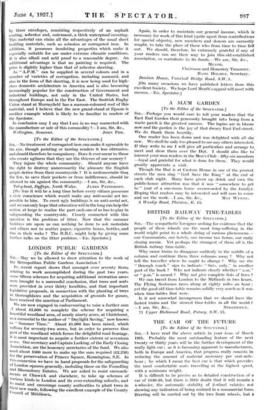THE CAR . OF THE FUTURE
[To the Editor of the SPECTATOR.]
have read the above article in your issue of March 19th. Probably the most outstanding feature of the next twenty or thirty years will be the further development of the really light car ; as it is becoming apparent to manufacturers, both in Europe and America, that progress really consists in reducing the amount of material necessary per seat-mile- hour ; by which I mean the best car is that which provides the most comfortable seats travelling at the highest speed, with a minimum weight.
It is difficult to be precise as to detailed construction of a car of 1940-50, but there is little doubt that it will remain a 4-wheeler, the automatic stability of 2-wheel vehicles not showing any indication of being realized in a commercial form. Steering will be carried out by the two front wheels. but
rearrangement of the power units will doubtless occur very soon. At present the engine occupies the best position in the chassis, and before long it (or possibly they, as there is a likeli- hood of more than one engine being used) will be placed at the rear of the vehicle ; or, if the size is sufficiently reduced, half- way between the front and rear axles,•but below the floor line. This will involve a modification of the accepted notions of grace in outlines, and a considerable amount of pioneer work to' change public opinion as to what constitutes a suitable shape for a fast moving vehicle.
Motoring for pleasure, as distinct from business journeys, will become more common. To this end the car must be an observation vehicle, and the ideal body would be one of flexible glass. As this material does not seem likely to be available within the next thirty years, greater use will be made of existing transparent materials ; their use being extended to the supporting pillars, and probably the whole roof will be
made as a sliding window.—I am, Sir, &c., S. F. EDGE. High House, Thames Dillon.







































 Previous page
Previous page